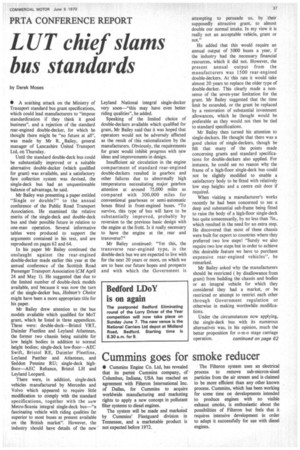LUT chief slams bus standards
Page 39

If you've noticed an error in this article please click here to report it so we can fix it.
by Derek Moses
• A scathing attack on the Ministry of Transport standard bus grant specifications, which could lead manufacturers to "impose standardization if they think it good business", and a rejection of the standard rear-engined double-decker, for which he thought there might be "no future at all", was made by Mr R. Bailey, general manager of Lancashire United Transport Ltd, on Thursday.
Until the standard double-deck bus could be substantially improved or a suitable alternative double-decker (which qualified for grant) was available, and a satisfactory fare collection system was devised, the single-deck bus had an unquestionable balance of advantage, he said Mr Bailey was presenting a paper entitled "Single or double?" to the annual conference of the Public Road Transport Association. He examined the relative merits of the single-deck and double-deck bus and their possible future in relation to one-man operation. Several informative tables were produced to support the arguments contained in his text, and are reproduced on pages 62 and 64.
In his paper Mr Bailey continued the onslaught against the rear-engined double-decker made earlier this year at the annual conference of the Scottish Road Passenger Transport Association (CM April 24 and May 1). He suggested that due to the limited number of double-deck models available, and because it was now the turn of the single-decker bus, Hobson 's Choice might have been a more appropriate title for his paper.
Mr Bailey drew attention to the bus models available which qualified for MoT grant, which he listed in three appendices. These were: double-deck—Bristol VRT, Daintier Fleetlirte and Leyland Atlantean, the former two chassis being suitable for low height bodies in addition to normal height bodies; single-deck low-floor—AEC Swift, Bristol RE, Daimler Fleetline, Leyland Panther and Atlantean, and Seddon Pennine RU; single-deck highfloor—AEC Reliance, Bristol LH and Leyland Leopard.
There were, in addition, single-deck vehicles manufactured by Mercedes and Volvo which appeared to require little modification to comply with the standard specifications, together with the new Metro-Scania integral single-deck bus—"a fascinating vehicle with riding qualities far superior to most buses at present available on the British market". However, the industry should have details of the new Leyland National integral single-decker very soon—"this may have even better riding qualities", he added.
Speaking of the limited choice of double-deckers available which qualified for grant, Mr Bailey said that it was hoped that operators would not be adversely affected as the result of this rationalization by the manufacturers. Obviously, the requirements for grant would inhibit progress with new ideas and improvements in design.
Insufficient air circulation in the engine compartment of standard rear-engined double-deckers resulted in gearbox and other failures due to abnormally high temperatures necessitating major gearbox attention at around 75,000 miles as compared with 300,000 miles for conventional gearboxes or semi-automatic boxes fitted in front-engined buses. "To survive, this type of bus will have to be substantially improved, probably by reversion to the previous basic design with the engine at the froht. Is it really necessary to have the engine at the rear and transverse?"
Mr Bailey continued: "Yet this, the transverse rear-engined type, is the double-deck bus we are expected to live with for the next 20 years or more, on which we are to base our future hopes and prospects and with which the Government is
attempting to persuade us, by their supposedly attractive grant, to almost double our normal intake. In my view it is really not an acceptable vehicle, grant or not."
He added that this would require an annual output of 5000 buses a year, if the industry had the necessary financial resources, which it did not. However, the present annual output from the manufacturers was 1500 rear-engined double-deckers. At• this rate it would take almost 20 years to replace the older type of double-decker. This clearly made a nonsense of the seven-year limitation for the grant. Mr Bailey suggested that the time limit be extended, or the grant be replaced by a restoration of substantial investment allowances, which he thought would be preferable as they would not then be tied to standard specifications.
Mr Bailey then turned his attention to single-deckers. He thought that there was a good choice of single-deckers, though he felt that many of the points made concerning grants and standard specifica tions for double-deckers also applied. For instance, he could see no reason why the frame of a high-floor single-deck bus could not be slightly modified to enable a satisfactory body to be fitted with relatively low step heights and a centre exit door if required.
When visiting a manufacturer's works recently he had been concerned to see a deep and substantial sub-frame being fitted to raise the body of a high-floor single-deck bus quite unnecessarily, by no less than 7n., which resulted in the need for an extra step.
He discovered that most of these chassis were built for export to countries where they preferred two low steps! "Surely we also require two low steps but in order to achieve this desirable feature we have to purchase expensive rear-engined vehicles", he remarked.
Mr Bailey asked why the manufacturers should be restricted ( by disallowance from grant) from building the chassis and bodies or an integral vehicle for which they considered they had a market, or be restricted or attempt to restrict each other through Government regulation or otherwise in making worthwhile modifications.
Under the circumstances now applying, the single-deck bus with its numerous alternatives was, in his opinion, much the better proposition for o-m-o stage carriage
operation. continued on page 62




























































































































































































